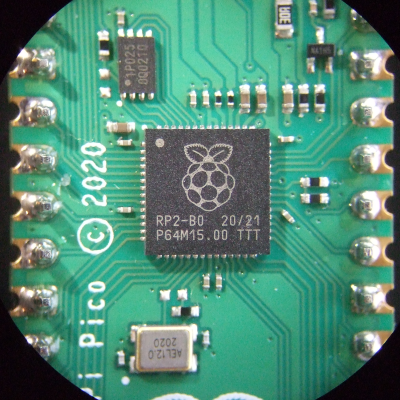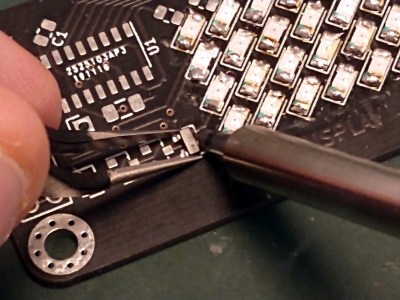Using Your Phone as a Microscope on the Electronics Workbench
One aspect of working for Hackaday comes in our regular need to take good quality photographs for publication. I have a semi-decent camera that turns my inept pointing and shooting into passably good images, but sometimes the easiest and quickest way to capture something is to pull out my mobile phone.
It’s a risky step because phone camera modules and lenses are tiny compared to their higher quality cousins, and sometimes the picture that looks good on the phone screen can look awful in a web browser. You quickly learn never to zoom on a mobile phone camera because it’s inevitably a digital zoom that simply delivers grainy interpolated pictures.
That’s not to say that the zoom can’t be useful. Recently I had some unexpected inspiration when using a smartphone camera as a magnifier to read the writing on a chip. I don’t need an archival copy of the image… I just needed a quick magnifying tool. Have I been carrying a capable magnifier for soldering in my pocket or handbag for years without realising it? I decided to give it a try and it worked okay with a few caveats. While I have seen optics turn these cameras into pretty good microscopes, my setup added nothing more than a phone tripod, and will get you by in a pinch.
What’s Your Magnifier Of Choice?

There was a time when I was much younger in which I remember being able to read the text on a SOT-23 transistor, but sadly even now wearing glasses those days are long past. Fortunately for me though I have a huge variety of options for soldering magnification. At various times I’ve used desktop magnifiers and headband magnifiers, but I’ve settled upon a large lens on an Anglepoise-style arm — you know, the springy lamp kind. These lens-on-an-arm are very common with beauty therapists and the like, utilizing a powerful ring of LED lights and providing ample magnification even for my eyes. I’ve also used various different LCD magnifiers belonging to friends and hackerspaces, but while I an extremely impressed by them I’ve so far been put off by the price for decent ones (even if I’ve brought you a super-cheap alternative via the unexpected medium of an ear cleaning camera in the past). My colleague Elliot meanwhile uses a very high quality 1970s binocular examination microscope that delivers exceptional quality, an instrument he swears by and which you will sometimes see being used in his work like the recent Raspberry Pi Pico review.
With all this very usable and capable equipment to hand it’s very clear that a mobile phone would have to be an exceptionally good alternative if it were to supplant them. But how about as a quick in-the-field option to sit alongside what you already have? Time to give it a try, and solder something with it.
Useful For More Than Cat Pictures? We give Our Phone A Try

The phones I had to hand were nothing special, the mid-range Huawei and Motorola Android devices that are my constant companions for both business and personal use. No high-end flagship cameras here, but the current generation of decent-ish phone cameras with which they gave similar results. I’m guessing that almost any smartphone made over the last few years could be pressed into service here. I put it on the mini tripod I use for Hackaday close-up shots, and pulled out a half-finished kit for a bit of soldering practice.
The image on maximum zoom provides plenty of magnification, and provides a high quality view of the work. In that context it’s better than my big magnifier, as it can deliver a closer view. The positive news ends though when the work starts, as a small but noticeable delay between action and screen leads to something of a learning curve as your soldering technique adapts. Perhaps more disconcerting is an unexpected disorientation in what I can only describe in perspective terms if that’s possible on a 2D display. These effects hold a fascination for me as someone who can’t see stereoscopic 3D, so why does a real 2D LCD microscope not have this problem? I am theorising when I say this, but I suspect that the solution lies in the camera’s depth of field. A mobile phone is designed to take reasonable pictures of everything in its field of view, so it has a particularly wide depth of field. The microscope meanwhile is designed to bring objects at a particular distance into sharp focus, so with its narrow depth of field it transmits some depth information in terms of focus. Our brains subconsciously process this, making depth placement of a soldering iron an easier process.
So I was able to solder a few components successfully through my phone’s view of the world. The slight delay and lack of perspective took a little getting around, and I can’t honestly recommend this technique for anybody’s bench. It does however remain a just-about-viable solution for impromptu SMD soldering in the field, but I’d advise you to practice a little before working on anything you care about. Perhaps a better bet would be to put one of those ear cameras I mentioned in your field toolkit alongside your miniature soldering iron, and use the mobile phone instead as its display. Everything is worth trying once, but perhaps a phone as an SMD soldering aid isn’t worth trying twice.
Post a Comment